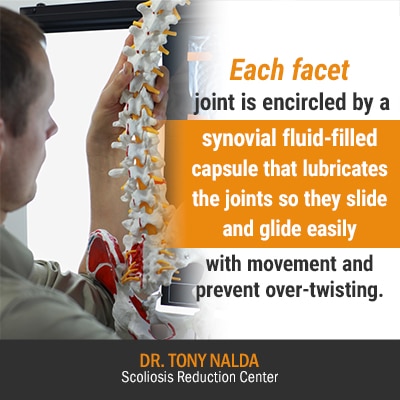As the brain and spine work in tandem to form the central nervous system (CNS), spinal conditions can impact the body in different areas, and not just in the back. The facet joints of the spine give it structure and flexibility. When a facet joint experiences degenerative changes, it compromises the health and function of the entire joint complex, including adjacent vertebrae and their intervertebral disc.
The vertebrae (bones of the spine) are connected by facet joints, through which the nerves of the central nervous system pass. Facet joint syndrome develops when the joints become swollen due to arthritis or spinal injury; it can affect any section of the spine and cause a range of symptoms.
Before getting into the specifics of facet joint syndrome, including types, symptoms, and treatment, let’s touch on some basic spinal anatomy for a better general understanding of how facet joint syndrome impacts the spine’s overall health and function.
Anatomy of a Healthy Spine
The spine consists of many moving parts, including the vertebrae, intervertebral discs, and facet joints.
There are three main sections of the spine: cervical (neck), thoracic (middle/upper back), and lumbar (lower back).
Each spinal section has a characteristic spinal curve that either bends inwards, towards the body’s center, or outwards, away from the body’s center.
The spine’s health and function depend on its ability to maintain its natural and healthy curvatures as the spine’s curves give it added strength, flexibility and allow it to support the weight of the body and distribute mechanical stress.
The vertebrae are separated by intervertebral discs that are tough and durable on the outside and soft and flexible on the inside; they help give the spine structure, flexibility, and act as its shock absorbers.
Facet joints are pairs of small joints that sit between the spine’s vertebrae; they have cartilage surfaces on all sides to help provide cushioning between the vertebrae so they don’t rub up against each other during movement create friction, as this would cause spinal degeneration and uneven wear.

Each facet joint is encircled by a synovial fluid-filled capsule that lubricates the joints so they slide and glide easily with movement and prevent over-twisting.
Each segment of the spine consists of adjacent vertebrae, attached by an intervertebral disc and posterior-paired facet joints, which form a three-joint structure. Each individual component’s health and function influences the others.
When one vertebral body or joint faces degenerative changes, the biomechanics of the entire structural segment is affected.
What is Facet Joint Syndrome?
Now that we’ve discussed some basic spinal anatomy, including the spine’s roles and structure, including its vertebrae, healthy curvatures, intervertebral discs, and facet joints, let’s address the specifics of facet joint syndrome.
When a facet joint starts to degenerate, the syndrome can be caused by an arthritis-like spinal condition, such as osteoarthritis, and can cause significant amounts of back pain.
When the cartilage inside the facet joint starts to break down and/or become inflamed, it can no longer facilitate the sliding/gliding motion of the joints during movement, and this can trigger pain signals in nerve endings surrounding the affected spinal segment.
As is the case with many spinal conditions, there are different types of facet joint syndrome, including cervical facet joint syndrome, which refers to facet joint degeneration occurring in the neck, and lumbar facet joint syndrome when the condition develops in the lower back: the most common site.
When it comes to back pain, lower back pain is the most common, and this is understandable as it’s the lower back that has to support the majority of the body’s weight.
One of the most common sources of facet-joint pain is facet joint degenerative osteoarthritis, related to the degeneration of the intervertebral discs.
As a synovial-lined joint, when facet joints lose fluid and cartilage and/or develop bony overgrowths, it can involve a loss of joint space, which narrows the path through which important spinal nerves travel, interfering with signals passing between the brain, spine, and the rest of the body.
Rheumatoid arthritis and ankylosing spondylitis also involve the facet joints.
When facet joints, and surrounding tissues, become inflamed due to degeneration, this is regarded as the main cause of localized pain: a prime symptom of facet joint syndrome.
Facet Joint Syndrome Symptoms
People with facet joint syndrome can experience varying symptoms, determined largely by patient age and overall spinal health, the source of degeneration, where the affected joint is located, and the degree of nerve involvement.
Quite commonly, patients experience the feeling of having to turn their whole body to look left or right, rather than having a range of spinal flexibility that facilitates a healthy and smooth twisting motion.

The stiffness and pain associated with facet joint syndrome can also cause difficulty standing up straight, or getting up from a seated position.
Another symptom is gait changes; people with facet joint syndrome can walk hunched over as posture can take on a pitched-forward appearance due to the challenges of standing up straight.
If a facet joint becomes significantly swollen and/or enlarged, it can encroach upon the space within the spine through which nerve roots pass, causing a pinched nerve: facet hypertrophy.
Now that we have defined the condition and what it can be like to live with, in terms of treatment, what can one do about it?
Facet Joint Syndrome Treatment
Here at the Scoliosis Reduction Center®, when treating a variety of spinal conditions, I combine multiple treatment disciplines for the best results, facet joint syndrome included.
Combining different treatment modalities allows me to fully customize each and every treatment plan and impact a condition on multiple levels.
My integrative conservative approach allows patients to benefit from what different forms of treatment offer; by monitoring how a patient’s spine is responding, I can modify treatment throughout the process by apportioning the disciplines according to the unique needs of each patient and their condition.
To address the specifics of facet joint syndrome, conservative treatment can involve a combination of alternating hot/cold therapy to help relax muscles, increase circulation, and reduce pain.
Lifestyle guidance is also a big part of the Center’s approach; after all, I don’t want to treat a patient only to have them return with the same problem.
For treatment results to be sustained, work needs to continue at home in many cases. It can involve addressing lifestyle choices that can play a role in the development/management/treatment of facet joint syndrome.
A big part of lifestyle guidance is educating patients on how to best support their lumbar spine, which involves maintaining natural and healthy spinal alignment.
I can tell a lot about a patient’s condition by their posture and gait, so I guide how patients can work towards lumbar support by improving natural spinal alignment and the ergonomics of proper sitting, standing, moving, lifting, etc. overall posture.
Good posture is often undervalued, but a body that holds and carries itself properly puts less stress on the joints of the spine, which helps create an environment that’s more conducive to healing and responsive to treatment.
In addition, knowing the types of activities that should be avoided or approached with caution by people with facet joint syndrome is another important aspect of treatment.
While every case is different, in general, any activities that worsen back pain should be avoided, including activities that involve spinal twisting, repeated bending and spinal extension, as well as sitting for long periods of time; these types of movements and activities expose the spine to adverse tension and strain, and if not avoided, can cause further damage and spinal degeneration.
It is, however, important to understand that while certain activities and types of movement should be avoided, that is not the same as saying “lead a sedentary lifestyle.”
The very design of the spine is based on movement, so part of the treatment also involves educating patients on the importance of healthy movement and the power of therapeutic low-impact exercise.
Carrying excess weight is also a lifestyle aspect that has to be addressed for those with facet joint syndrome. Increasing the load that the spine has to support puts excess wear and tear on its joints, facet joints included, and intervertebral discs.
Physical therapy involves creating a routine that involves simple and effective condition-specific exercises that help keep the spine and its surrounding muscles as strong, loose, and flexible as possible.
While not a common form of treatment for facet joint syndrome, when appropriate, I can also prescribe the short-term use of a corrective brace to help with spinal stability and limit spinal motion while healing.
As a chiropractor, I also use a variety of chiropractic spinal-manipulative therapies to promote spinal alignment; as we know, a spine that’s aligned is better able to maintain its natural curvatures so that it can function optimally.
Conclusion
While facet joint syndrome can develop anywhere along the spine, it’s most commonly found in the lower back as the lumbar spine supports the most bodyweight.
As facet joint syndrome involves the joints that connect the bones of the spine, even if a single facet joint starts to deteriorate, it affects not just itself but also adjacent vertebrae, the spinal segment’s intervertebral disc, and surrounding muscles and nerves.
While there are different severity ranges, facet joint syndrome most commonly causes localized back pain, and radicular pain when nerves are involved. Additional symptoms include difficulties with standing up straight and standing up from a seated position, a reduced range in spinal flexibility, particularly when it comes to twisting motions, and stiffness in the spine and its surrounding muscles.
When it comes to facet joint syndrome treatment, here at the Scoliosis Reduction Center®, my patients benefit from what a combination of multiple proactive treatment modalities can achieve.
Physical therapy promotes a healthy activity level and increases core and spinal strength, and adverse tension and pressure caused by deteriorating facet joints can be reduced, improving the spine’s overall health, function, and biomechanics.
By integrating additional therapies, lifestyle guidance, and condition-specific chiropractic care, I can help patients work towards changes that improve spinal health, healing, and responsiveness to treatment, not to mention the use of spinal-manipulation therapy to promote optimal spinal alignment and weight distribution.





